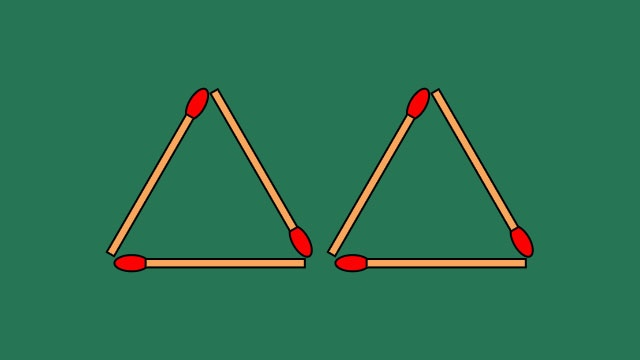Matchstick puzzles are classic brain teasers that test your ability to think creatively and spot unconventional solutions. The goal is often simple—move one or more matchsticks to form a specific shape or number. Today, we’re tackling an intriguing challenge: “Move 1 matchstick to form four triangles.” While this might sound straightforward, it actually requires a shift in perspective to solve.

In this article, we’ll break down the puzzle step by step, highlight common mistakes, and reveal the solution. So, let’s get started!
The Challenge: Move 1 Matchstick to Create Four Triangles
The setup is simple. You have a series of matchsticks arranged to form two equilateral triangles. Your task is to move just one matchstick to create four equilateral triangles. Sounds easy, right? But as you’ll soon see, this puzzle has a clever twist that often stumps solvers.
Why Matchstick Puzzles Are Tricky
Matchstick puzzles are deceptive in their simplicity. While they might look easy at first glance, they often require you to think beyond your initial assumptions. Here are a few reasons why people find them challenging:
1. Focus on 2D Thinking
Most people assume that the solution exists within a two-dimensional plane, simply rearranging the matchsticks on a flat surface. However, many matchstick puzzles require you to think in three dimensions or visualize shapes differently.
2. Overlooking Key Matchsticks
People often get stuck because they move the wrong matchstick. In this puzzle, finding the critical matchstick is crucial, as moving the wrong one won’t create the desired outcome.
3. Ignoring Small Details
The key to solving matchstick puzzles often lies in the details—a small movement can dramatically change the structure. You need to pay attention to how each matchstick contributes to the overall shape.
Understanding these pitfalls is essential for solving the matchstick puzzle successfully.
Analyzing the Current Setup: Two Triangles
Before moving any matchsticks, let’s observe the current arrangement:
- You start with two equilateral triangles, formed by six matchsticks.
- The goal is to create four triangles by moving just one matchstick.
The challenge here is to figure out which matchstick to move and where to place it.
Step-by-Step Solution: Move One Matchstick to Create Four Triangles
Now that we understand the setup, let’s dive into the solution. The trick is to think beyond two dimensions and visualize the puzzle from a different perspective.
Step 1: Identify the Key Matchstick
The solution requires moving one specific matchstick to form four equilateral triangles. Most people assume that the triangles must be created in a two-dimensional plane, but this puzzle actually involves creating a three-dimensional structure.
Step 2: Make the Key Move
To solve the puzzle, move the middle matchstick that’s shared between the two existing triangles. Here’s what you do:
- Lift the vertical matchstick from one of the triangles.
- Place it upright on top of the center of the existing structure, creating a pyramid shape.
Step 3: Visualize the New Structure
Once the matchstick is moved to the center and placed vertically, you’ll notice that the matchsticks now form a tetrahedron—a three-dimensional shape with four equilateral triangles.
The tetrahedron’s structure includes:
- Three triangles at the base.
- One triangle formed by the sides of the pyramid.
Why This Solution Works
The key to solving this puzzle is realizing that the matchsticks can form three-dimensional shapes. By creating a pyramid (or tetrahedron), you break free from the two-dimensional plane and satisfy the puzzle’s requirement of forming four triangles.
This solution challenges the assumption that all shapes must be flat. Instead, it pushes you to think about geometry in a more spatial way.
Common Mistakes When Solving This Puzzle
Even with a clear solution, many people struggle with this matchstick puzzle. Here are some common errors that solvers make:
1. Moving the Wrong Matchstick
People often try to move a matchstick from the perimeter of the existing triangles, thinking that rearranging them will create more triangles. However, the solution lies in moving the middle matchstick.
2. Ignoring 3D Possibilities
This puzzle requires you to think three-dimensionally. If you limit your thinking to a two-dimensional plane, you won’t see the solution.
3. Overcomplicating the Move
Some solvers try to create complex shapes by moving the matchstick in unusual ways. The solution, however, is surprisingly simple—it just requires placing the matchstick upright
Conclusion: Did You Solve the Puzzle?
Congratulations if you managed to solve this matchstick puzzle by forming four triangles! If you struggled, don’t worry—these puzzles are designed to challenge conventional thinking and encourage creativity.
Matchstick puzzles are more than just fun games; they’re exercises in spatial reasoning and problem-solving. By thinking outside the box, you can approach other challenges with a fresh perspective and a sharper mind.
So, what did you think of this matchstick puzzle? Did it surprise you, or did you find the steps helpful? If you enjoyed this challenge, try other matchstick puzzles that test your logic and creativity. Keep pushing your mind, and who knows—maybe the next puzzle will be even more fun!


